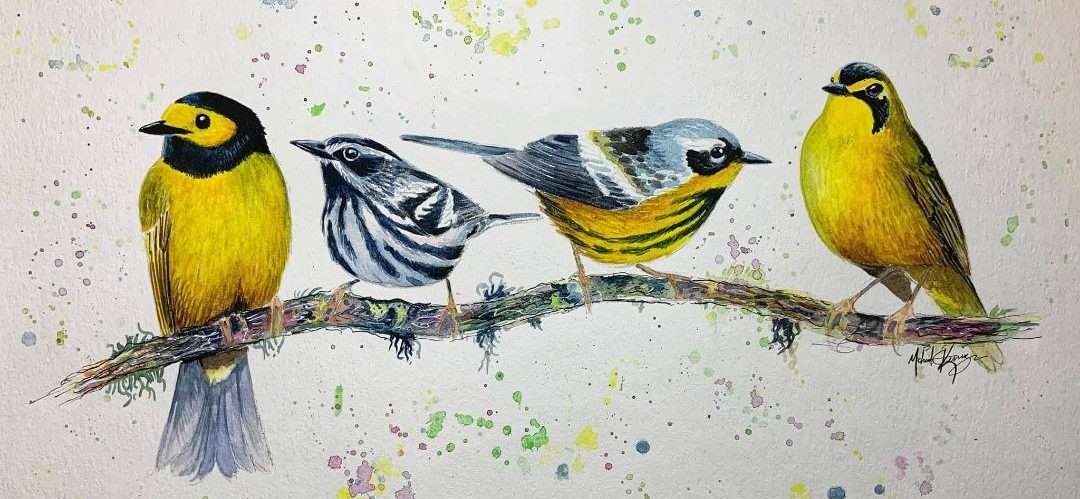JVAS President’s Message
It was an early Autumn morning and the sun was just peaking over the mountain top. I could hear the Red-winged blackbirds and Song Sparrows wake up the neighborhood. I was enjoying a fresh cup of shade grown Lenca Farms coffee, and that was when I heard the sound that makes all of us bird lovers just cringe. Yes, it was a loud thud against the window from an alluring Red-eyed Vireo.

With the white eyebrow stripe bordered above and below by blackish lines, this olive-green colored bird was certainly dazed but did not appear to have any other injuries such as a broken wing. I held the bird for a few minutes to see if it would come to and fly-off, but it seemed comfortable in my hands. I have read that birds can overheat in your hands, so I didn’t want to hold this adult bird longer than necessary. I got a shoebox and softened the bottom with some cloth. After 15 minutes, I opened the box and the bird was clearly calm and alert, ready to take flight once again.
Sadly, in many of window strike cases, birds suffer serious injuries such as internal hemorrhages, concussions, or damage to their bills, wings, eyes, or skulls. Window collisions kill vast numbers of birds in the United States each year and is reported to be at least a billion birds per year.
Here are some strategies from the National Audubon website to help protect our bird friends from window strikes:
- Make windows look like a barrier to birds, such as:
- Window decals may help, but they must be placed no more than 2-4 inches apart in order to be effective. Birds will try to fly through larger gaps. This means that on large windows, many closely spaced decals may be necessary to deter bird collisions.
- Create temporary designs with window markers or tempera paints, soap, or hang ribbons on window exteriors. Again, designs or ribbons should be placed no more than 2-4 inches apart.
- Install external screens or netting on windows. When done effectively, external screens can break up reflections or can slow birds down before they hit the glass.
- Close window drapes or blinds partially or completely whenever possible. This is especially important at night when interior lights are in use.
- Position feeders either directly on a window with suction cups or within 3 feet.
- Avoid placing plants near windows inside your home.
Thanks for helping keep our birds safe!
—John Carter
Additional Solutions
Mike and I have also found birds that were injured or killed by flying into a window. Most of the problems occurred outside our big kitchen window, in the back yard where we have bird feeders and a bubbling boulder to provide water for wildlife. The kitchen window reflects the forest that surrounds our backyard, so it’s no wonder that birds fly into the glass. Birds don’t realize that they see a reflection; they think they are flying into the forest.
One thing that does work is screening. Frank Haas, a well-known Pennsylvania birder, started the Bird Screen Company. His products do work, by providing a screen that deters most birds from hitting the windows. The screens are not flush with the window and have enough tension, so birds that hit the screen bounce off without being injured. We bought enough screens to cover our kitchen window and thought we had the problem solved, until our backyard bears discovered the suction cups that attached the screens to the windows. For some reason, the bears delighted in removing the suction cups, rendering the screens useless.
Still searching we found a product called Bird Crash Preventer. This setup has easy-to-install brackets that held up a curtain of fishing line spaced 4 in. apart and fastened to brackets below. The fishing line is very reflective, so birds avoid the “curtain.” However, we found that small birds like American Goldfinches would fly between the fishing line and hit the window. We then strung more fishing line to make the gap just 2 inches apart. This helped, but a few birds still hit the window. Next, we bought black garden nylon netting sold in hardware stores used to cover fruit trees and shrubs. We strung this on top of the fishing line, attached it to the brackets, and pulled it taut. When birds hit the netting, they just bounce off without being injured. Voila! Problem solved.
There are other solutions, too. Check out Acopian Bird Savers (Zen Wind Curtains). You can purchase this solution or make your own. This product has been scientifically shown to be effective. You can download the research papers from the website.
—Laura Jackson


